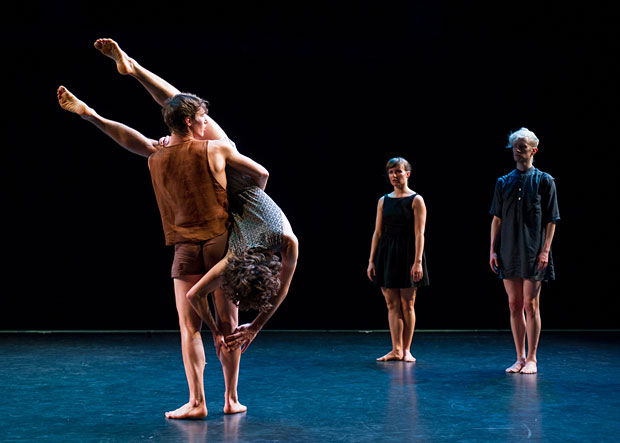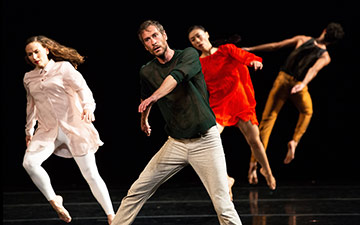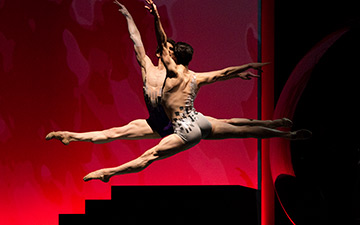
© Ian Douglas. (Click image for larger version)
Back to Ballet
Tere O’Connor Dance
2 New Works: poem, Secret Mary
New York, New York Live Arts
30 November 2012
tereoconnordance.org
www.newyorklivearts.org
Tere O’Connor can be a frustrating choreographer. Look for structure and you’ll likely be thwarted, frustrated, or worse. Because it clearly is there, but you can’t understand it. The usual signposts – music, narrative, development – don’t help. As he himself states, his interest lies in “placing distinctly unrelated strains of material into complex relational networks that do not search to create narrative resolution.” That’s just the way his mind works. It’s an insider’s game: you can sense that the dancers know why they do certain things at certain times, but you, the viewer, are not privy to that logic.
That said, there is a certain degree of pleasure to be had in watching his dances, like the fascination of watching natural processes or the strange behavior of your neighbors across the way. What are these people thinking? Why do they do what they do? O’Connor’s recent evening at New York Live Arts consisted of two works, Secret Mary and poem. The two are quite dissimilar, but have certain points of convergence. First of all, an interest in ballet. It may seem odd that someone who has dedicated so many years to experimentation and broadening the scope of dance should feel so visibly drawn to the balletic vocabulary. Perhaps it’s a reflection of the current makeup of his company, which includes several dancers with serious ballet training and/or professional experience in ballet companies (like Ryan Kelly, a former New York City Ballet dancer). It seems increasingly true that all Western dancers, no matter what style they work in, have a base in classical technique. The ballet training has become the degree zero of dance, more than a century after Isadora Duncan’s rejection of classical technique. Perhaps O’Connor is commenting on this state of affairs. Both works contained clearly recognizable ballet steps: tendus, fifth position arms, a brisé volé here, pirouettes in coupé there, delicately crossed wrists, arabesques penchées, turnout (not always, and not extreme, but it clearly stated), pointed toes.

© Ian Douglas. (Click image for larger version)
Clearly O’Connor has ballet on his mind – the harmony of forms, the expansiveness of technique. This is especially true in the second work, poem, the more tightly-constructed of the two. As it begins the dancers run on, chest open to the sky, head thrown back, arms open like wings. This rush of movement is exciting, especially after the sometimes frustrating introspection of the first work, a series of dancers’ portraits. Poem is clearly about movement, pure and simple. It helps that O’Connor was able to lure the former Cunningham dancer, Silas Riener, currently one of the most thrilling performers around, into his company. Riener, who danced a series of electrifying solos during the Cunningham Company’s final year, is clearly having a moment. His dancing has an amazing plasticity and clarity – it looks etched in glass – and throbs with inner life. In fact he sometimes seems so focused on what is happening inside his head that he creates the impression of dancing alone, even when he is with others. It’s a strange but fascinating effect, amplified by his often quizzical, almost angry expression. What’s he fighting against? He can make the movement of a hand, or his fingers – and there are a lot of “finger dances” in these two works – look like the most interesting thing in the world, as if one had never seen fingers move this way before.
The entire cast of five rises to the occasion, dancing with a kind of sharp-edged attack that one doesn’t always identify with O’Connor’s work. Fewer quirks, more expansiveness. Each dancer shades the overall tone with his or her own personal qualities: Natalie Green is dramatic, Heather Olson deadpan, Michael Ingle heroic and pure, Oisín Monaghan elfin and cool. The piece is subdivided into thematic sections, following fast upon each other. Toward the beginning the men form a circle and move their legs like Busby Berkeley beauties; much later, there is a partnering section in which the dancers pick each other up in various poses and quickly put each other down, like stop-action phrases; somewhere in between, there is a passage of fast, rhythmic footwork reminiscent of Cunningham; at another point, a sequence filled with skating steps. Meanwhile the stage teems with activity: there are always at least 3 things to look at once. The dancers pair up, hold hands, face off, disperse. Music – sometimes rhythmic, sometimes more in the vein of ambient noises and static – alternates with sounds from nature: water, birdcalls. Is there a higher meaning to be drawn from this? It’s hard to tell. Poem is never less than engaging, but one must allow oneself to enjoy it moment by moment. “This is the section where we do this,” the dancers seem to be saying, “and now, we do this.” With the exception of the final image, in which Silas Riener slowly wove his body onto that of Michael Ingle, whose pleading pose reminded me of a figure in a Baroque religious painting, the affect was neutral, impersonal, a bit cold. All the dancers seemed to be dancing for themselves.

© Ian Douglas. (Click image for larger version)
Secret Mary, performed first, was far less detached, though the four dancers did tend to stare out with heavy-lidded eyes, as if they had taken a strange drug that put them in into altered, though not un-lucid, state of mind. One of them, Tess Dworman, looked unbearably sad, as if she had heard terrible news just before the show. She started the piece off, flailing her arms and torso as the others stood to one side, discreetly watching. Secret Mary has a private, exploratory feel, as if the choreographer had worked with each dancer individually and then sewn these portraits together loosely at the end. The tall, delicate Mary Read, with her pixie haircut, was particularly affecting. Her hands betrayed a slight tremor, her big eyes on the verge of welling with tears. As she fluttered a hand, or stretched one arm almost out of its socket, this effort to dominate with her own body evoked a great internal struggle. The whole piece was performed in silence, or rather to the sounds of the dancer’s strangled breaths. A passage of funny, exaggerated walking reminded me of Monty Python’s “ministry of silly walks,” except that here there was no humor. But then, O’Connor is a rather humorless choreographer, it must be said. And a bit withholding. He doesn’t reveal much, except, one suspects, to his dancers.

















You must be logged in to post a comment.